Q1: As shown in the figure below, two concentric conducting spherical shells, centered at r = 0 and having radii r = c and r = d are maintained at potentials such that the potential V(r) at r = c is V1 and V(r) at r = d is V2. Assume that V(r) depends only on r, where r is the radial distance. The expression for V(r) in the region between r = c and r = d is (2022)
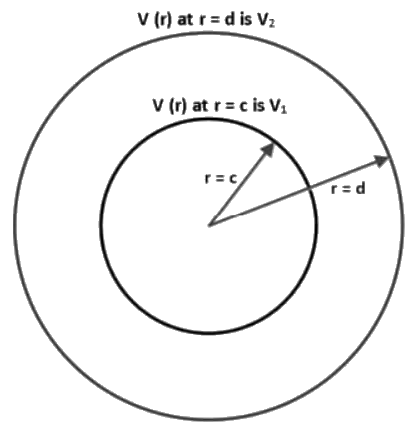 (a)
(a) 
(b) 
(c) 
(d) 
Ans: (b)
Sol: We have, Laplace equation
 V will have only radial component.
V will have only radial component.
From equation (1)
 Integrate both side
Integrate both side 
Again integrate,
Here, P and Q are constant.
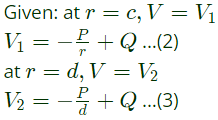 From eq. (2) & (3)
From eq. (2) & (3)
 From eq. (1),
From eq. (1),

Q2: Consider a large parallel plate capacitor. The gap 'd' between the two plates is filled entirely with a dielectric slab of relative permittivity 5. The plates are initially charged to a potential difference of V volts and then disconnected from the source. If the dielectric slab is pulled out completely, then the ratio of the new electric field E2 in the gap to the original electric field E1 is ________. (2021)
(a) 2
(b) 5
(c) 6
(d) 8
Ans: (b)
Sol: 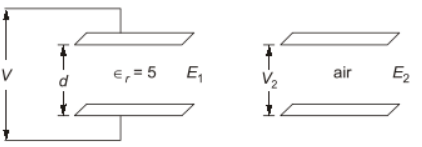 If voltage source is removed then in both cases charge O is constant.
If voltage source is removed then in both cases charge O is constant.



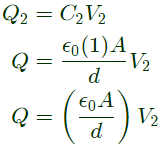 Equation (i) is equal to equation (ii)
Equation (i) is equal to equation (ii)
 ⇒ 5V1 = V2
⇒ 5V1 = V2
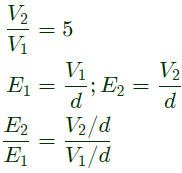 ⇒
⇒
Put equation (iii) in equation (iv),
⇒ E2/E1 = 5
Q3: A 1μC point charge is held at the origin of a cartesian coordinate system. If a second point charge o 10μC is moved from (0, 10, 0) to (5, 5, 5) and subsequently to (5, 0, 0), then the total work done is ___________ mJ. (Round off to 2 decimal places).
Take  in SI units. All coordinates are in meters. (2021)
in SI units. All coordinates are in meters. (2021)
(a) 5.25
(b) 9
(c) 8.62
(d) 2.47
Ans: (b)
Sol:  In this case work done is independent of type of path but depends an intial and final point.
In this case work done is independent of type of path but depends an intial and final point.
 Work done (by external source) in moving Q-charge (10 μC) in the presence of electric field
Work done (by external source) in moving Q-charge (10 μC) in the presence of electric field is
is 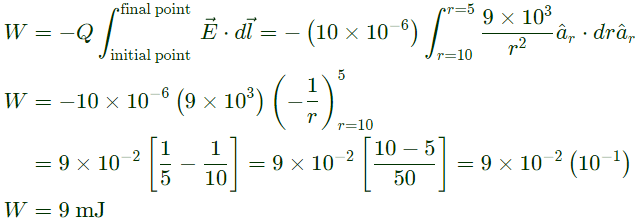
Q4: Let ar, aϕ and az be unit vectors along r, ϕ and z directions, respectively in the cylindrical coordinate system. For the electric flux density given by D = (ar15 + aϕ2r − az3rz) Coulomb/ m2, the total electric flux, in Coulomb, emanating from the volume enclosed by a solid cylinder of radius 3 m and height 5 m oriented along the z-axis with its base at the origin is: (2020)
(a) 108 π
(b) 54 π
(c) 90 π
(d) 180 π
Ans: (d)
Sol: 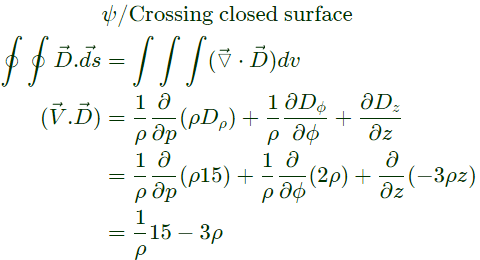

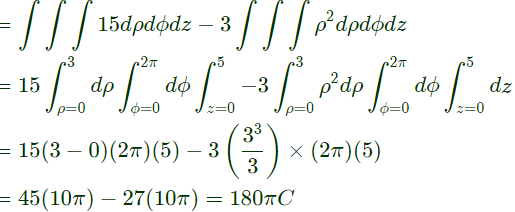
Q5: The static electric field inside a dielectric medium with relative permittivity, εr = 2.25, expressed in cylindrical coordinate system is given by the following expression
 where ar, aφ, az are unit vectors along r, φ and z directions, respectively. If the above expression represents a valid electrostatic field inside the medium, then the volume charge density associated with this field in terms of free space permittivity, ε0, in SI units is given by: (2020)
where ar, aφ, az are unit vectors along r, φ and z directions, respectively. If the above expression represents a valid electrostatic field inside the medium, then the volume charge density associated with this field in terms of free space permittivity, ε0, in SI units is given by: (2020)
(a) 3ε0
(b) 4ε0
(c) 5ε0
(d) 9ε0
Ans: (d)
Sol: 
volume charge density
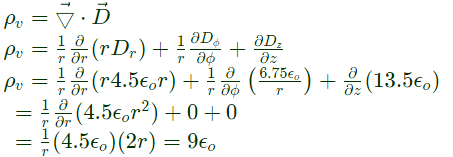
Q6: A co-axial cylindrical capacitor shown in Figure (i) has dielectric with relative permittivity εr1 = 2. When one-fourth portion of the dielectric is replaced with another dielectric ofrelative permittivity εr2, as shown in Figure (ii), the capacitance is doubled. The value of εr12 is ____. (2019)
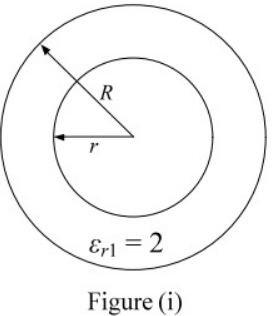
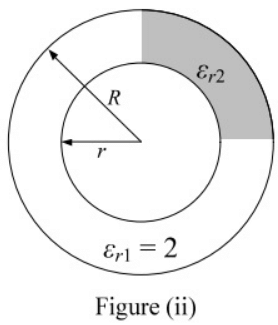 (a) 10
(a) 10
(b) 7
(c) 15
(d) 18
Ans: (a)
Sol: Co-axial cylindrical capacitor-1
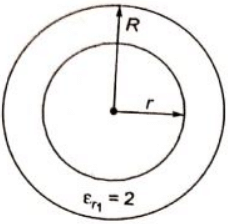
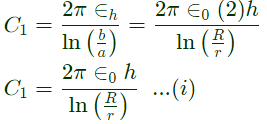 Co-axial cylindrical capacitor-2
Co-axial cylindrical capacitor-2

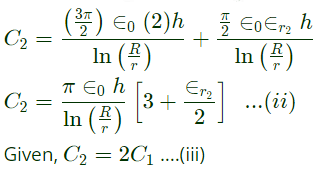 Put equation (i), (ii) in equation (iii),
Put equation (i), (ii) in equation (iii),
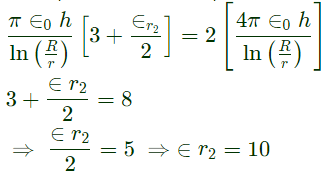
Q7: The capacitance of an air-filled parallel-plate capacitor is 60 pF. When a dielectric slab whose thickness is half the distance between the plates, is placed on one of the plates covering it entirely, the capacitance becomes 86 pF.Neglecting the fringing effects, the relative permittivity of the dielectric is ______ (up to 2 decimal places). (2018)
(a) 1.55
(b) 2.53
(c) 3.75
(d) 4.25
Ans: (b)
Sol: Given, C = 
In second case:
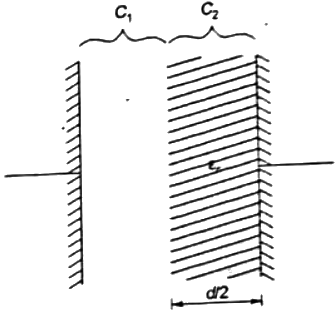 Capacitance,
Capacitance,
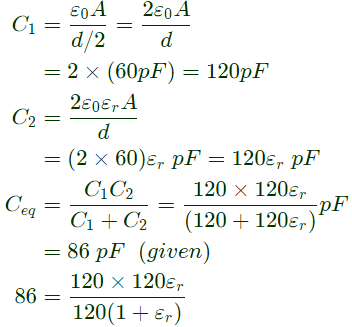
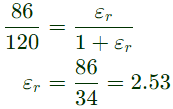
Q8: A positive charge of 1 nC is placed at (0, 0, 0.2) where all dimensions are in metres. Consider the x-y plane to be a conducting ground plane. Take ϵ0 = 8.85 × 10−12 F/m. The z component of the E field at (0, 0, 0.1) is closest to (2018)
(a) 899.18 V/m
(b) −899.18 V/m
(c) 999.09 V/m
(d) −999.09 V/m
Ans: (d)
Sol:  Net electric field at point P due to charge Q is,
Net electric field at point P due to charge Q is,

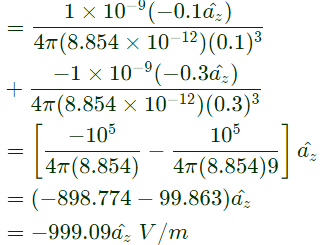
Q9: A thin soap bubble of radius R = 1 cm, and thickness a = 3.3μm(a < < R), is at a potential of 1 V with respect to a reference point at infinity. The bubble bursts and becomes a single spherical drop of soap (assuming all the soap is contained in the drop) of radius r. The volume of the soap in the thin bubble is 4πR2a and that of the drop is 4/3 πr3. The potential in volts, of the resulting single spherical drop with respect to the same reference point at infinity is __________. (Give the answer up to two decimal places.) (SET-2 (2017))
 (a) 10.03
(a) 10.03
(b) 20.25
(c) 30.28
(d) 40.08
Ans: (a)
Sol: After burst,
 Radius of soap drop = (3R2a)1/3 = 0.099665cm
Radius of soap drop = (3R2a)1/3 = 0.099665cm
Initial voltage was 1 V and C = 4πε0R
and initial charge, Q = 
Since after bursting Q remainsame and C = 4πε0r
New potential on soap drop,

Q10: Consider a solid sphere of radius 5 cm made of a perfect electric conductor. If one million electrons are added to this sphere, these electrons will be distributed. (SET-2 (2017))
(a) uniformly over the entire volume of the sphere
(b) uniformly over the outer surface of the sphere
(c) concentrated around the centre of the sphere
(d) along a straight line passing through the centre of the sphere
Ans: (b)
Sol: Added charge (one million electrons) to be solid spherical conductor is uniformly distributed over the outer surface of the sphere.
Q11: Consider an electron, a neutron and a proton initially at rest and placed along a straight line such that the neutron is exactly at the center of the line joining the electron and proton. At t = 0, the particles are released but are constrained to move along the same straight line. Which of these will collide first? (SET-1 (2017))
(a) The particles will never collide
(b) All will collide together
(c) Proton and Neutron
(d) Electron and Neutron
Ans: (d)
Sol: Given that electron, neutron and proton are in straight line.
 The electron will move towards proton and proton will move towards electron and force will be same
The electron will move towards proton and proton will move towards electron and force will be same  But acceleration of electron will be more than proton as mass of electron < mass of proton. Since neutron are neutral they will not move. Thus electron will hit neutron first.
But acceleration of electron will be more than proton as mass of electron < mass of proton. Since neutron are neutral they will not move. Thus electron will hit neutron first.
Q12: Two electrodes, whose cross-sectional view is shown in the figure below, are at the same potential. The maximum electric field will be at the point (SET-2 (2016))
 (a) (A)
(a) (A)
(b) (B)
(c) (C)
(d) (D)
Ans: (a)
Sol: 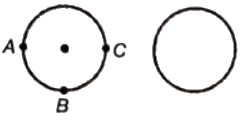 At the point C,
At the point C,  (electric field intensity) is maximum being closest to the other plate.
(electric field intensity) is maximum being closest to the other plate.
Q13: A parallel plate capacitor filled with two dielectrics is shown in the figure below. If the electric field in the region A is 4 kV/cm, the electric field in the region B, in kV/cm, is (SET-2 (2016))
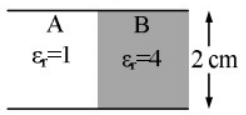 (a) 1
(a) 1
(b) 2
(c) 4
(d) 16
Ans: (c)
Sol: As voltage is same across both the regions and distance between two plates is also same, then electric field remains same throughout the both region. As we know, E = V/d = constant for both regions.
Q14: Two electric charges q and -2q are placed at (0, 0) and (6, 0) on the x-y plane. The equation of the zero equipotential curve in the x - y plane is (SET-1 (2016))
(a) x = -2
(b) y = 2
(c) x2 + y2 = 2
(d) (x + 2)2 + y2 = 16
Ans: (d)
Sol: Charge, Q is located at (0, 0) and −2θ is located at (6, 0).
To find V at any point (x, y)
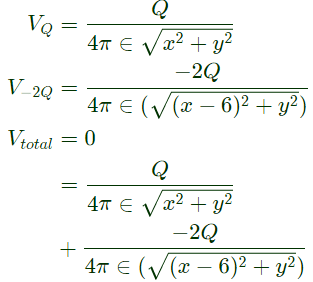
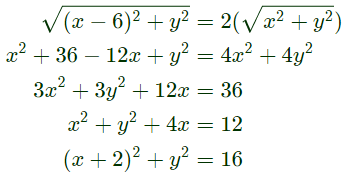
Q15: Two semi-infinite conducting sheets are placed at right angles to each other as shown in the figure. A point charge of +Q is placed at a distance of d from both sheets. The net force on the charge is  where K is given by (SET-2 (2015))
where K is given by (SET-2 (2015))
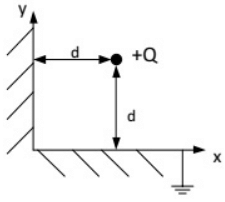 (a) 0
(a) 0
(b) 
(c) 
(d) 
Ans: (d)
Sol: Due to image of the charge, three new charges will be created as shown in figure
 Total force (4) due to (1), (2), (3) will be
Total force (4) due to (1), (2), (3) will be
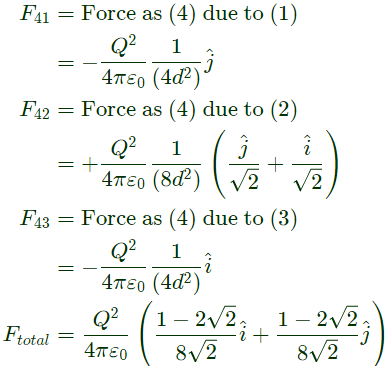
 (a)
(a) 



 V will have only radial component.
V will have only radial component. Integrate both side
Integrate both side 

 From eq. (2) & (3)
From eq. (2) & (3) From eq. (1),
From eq. (1),
 If voltage source is removed then in both cases charge O is constant.
If voltage source is removed then in both cases charge O is constant.


 Equation (i) is equal to equation (ii)
Equation (i) is equal to equation (ii) ⇒ 5V1 = V2
⇒ 5V1 = V2 ⇒
⇒
 in SI units. All coordinates are in meters. (2021)
in SI units. All coordinates are in meters. (2021) In this case work done is independent of type of path but depends an intial and final point.
In this case work done is independent of type of path but depends an intial and final point. Work done (by external source) in moving Q-charge (10 μC) in the presence of electric field
Work done (by external source) in moving Q-charge (10 μC) in the presence of electric field is
is 



 where ar, aφ, az are unit vectors along r, φ and z directions, respectively. If the above expression represents a valid electrostatic field inside the medium, then the volume charge density associated with this field in terms of free space permittivity, ε0, in SI units is given by: (2020)
where ar, aφ, az are unit vectors along r, φ and z directions, respectively. If the above expression represents a valid electrostatic field inside the medium, then the volume charge density associated with this field in terms of free space permittivity, ε0, in SI units is given by: (2020)


 (a) 10
(a) 10
 Co-axial cylindrical capacitor-2
Co-axial cylindrical capacitor-2
 Put equation (i), (ii) in equation (iii),
Put equation (i), (ii) in equation (iii),

 Capacitance,
Capacitance,

 Net electric field at point P due to charge Q is,
Net electric field at point P due to charge Q is,

 (a) 10.03
(a) 10.03 Radius of soap drop = (3R2a)1/3 = 0.099665cm
Radius of soap drop = (3R2a)1/3 = 0.099665cm

 The electron will move towards proton and proton will move towards electron and force will be same
The electron will move towards proton and proton will move towards electron and force will be same  But acceleration of electron will be more than proton as mass of electron < mass of proton. Since neutron are neutral they will not move. Thus electron will hit neutron first.
But acceleration of electron will be more than proton as mass of electron < mass of proton. Since neutron are neutral they will not move. Thus electron will hit neutron first. (a) (A)
(a) (A) At the point C,
At the point C,  (electric field intensity) is maximum being closest to the other plate.
(electric field intensity) is maximum being closest to the other plate. (a) 1
(a) 1

 where K is given by (SET-2 (2015))
where K is given by (SET-2 (2015)) (a) 0
(a) 0


 Total force (4) due to (1), (2), (3) will be
Total force (4) due to (1), (2), (3) will be


























